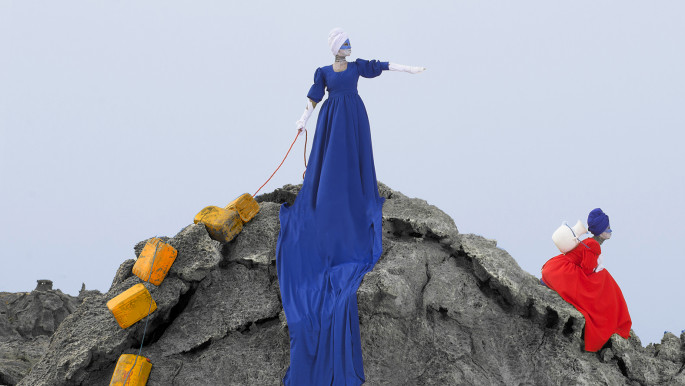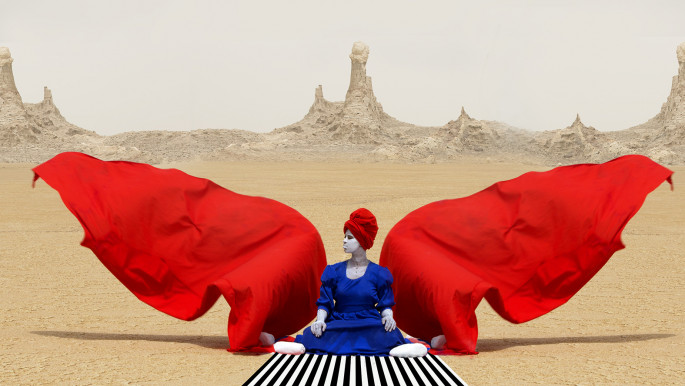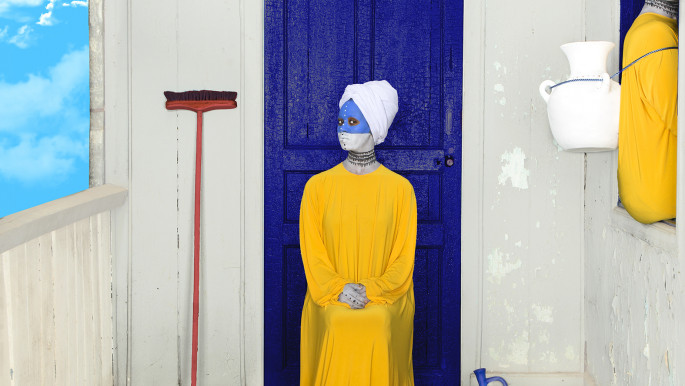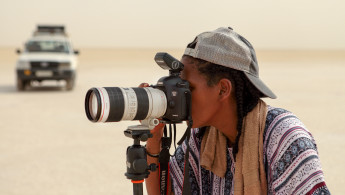On Arid Lands in Ethiopia: Aïda Muluneh's exhibition responds to the global water crisis
Recent years have witnessed some of the highest temperatures on record worldwide. As temperatures soared, water supplies depleted, threatening the lives of millions of people. It is now estimated that 1 in 10 people do not have access to a clean water supply near their homes and 31 percent of schools do not have clean water.
Ethiopian photographer Aïda Muluneh considers how the lack of access to clean water particularly impacts the livelihood of women in her home country in a new exhibition called Water Life.
In collaboration with Water Aid, Muluneh presents 12 photographs taken in the dramatic landscape of Dallol in Ethiopia, known as the hottest place on earth.
Using only female models, she combines bright primary colours with subtle symbolism to prompt her audience into questioning how the shortage of water affects the lives of others.
"I have travelled extensively not only around Ethiopia, but all of Africa and I often see the burden that women carry of having to transport water," Muluneh described at the exhibition opening.
 |
I have travelled extensively not only around Ethiopia, but all of Africa and I often see the burden that women carry of having to transport water |  |
The artist chose to shoot in Dallol because of its impenetrable and dramatic environment, which reached as high as 50°C during their five days on location.
"I thought it was important to go to this location not only because the landscape is really quite amazing but it was also a matter of how to gain in a very aggressive environment and get a sense and feel of it," Muluneh said. "To see people who are resilient and who are actually living under these conditions."
The artworks explore how the lack of access to clean water affects women on a daily basis; whether restricting young girls’ ability to attend school or placing responsibility on women to travel great distances each day to provide water for the family.
Many of the photographs particularly reference the impact on women living in rural Ethiopia.
"For those of us who live in cities, we often take for granted the privilege that we have in relation to water access, while the realities of those living beyond the city grid encounter challenges that not only impacts their health but also their capabilities to contribute to the development of their communities," explained Muluneh.
Knowing the Way to Tomorrow depicts two women atop a rocky mound. One is dressed in a bright red dress and rests on the rock, easing the burden of her “insera,” a traditional clay water pot that she carries on her back.
 |
This piece is a reflection on the strength of such women who have to endure great feats daily to ensure that their families have water to drink and food to eat |  |
 |
|
| [WATER AID/AIDA MULUNEH] |
At the peak of the rock stands another woman wearing a bold blue dress and pointing out into the distance. Attached to her hand is a rope connected to a row of jerry cans that trail behind her, as if to signify the conflict between the dreams that she has for the future against the responsibility to maintain water supplies for her family.
"This piece is a reflection on the strength of such women who have to endure great feats daily to ensure that their families have water to drink and food to eat, while in the midst of carrying not only the burden on their backs but the sacrifice they sustain," Muluneh explained.
In other works, the artist shines light on various ways in which a lack of water can hinder women.
Star Shine, Moon Glow shows a woman sitting cross legged on a striped carpet that extends out towards the tip of the frame. Two great red wings rise up behind her. The arid and sparse landscape is complimented by the moon which half-appears in the middle of the sky.
 |
It is like a caged bird that cannot fly but is grounded |  |
 |
|
| [WATER AID/AIDA MULUNEH] |
The work reflects the hindrance that a lack of clean water can have on young women during their menstrual cycles. In particular, when a girl’s school lacks running water, she is often forced to stay home during her cycle, preventing her from her education.
In the work, menstruation is symbolised by the moon and the wings illustrate the power of women but also the shackles that hold them back during the monthly menstrual cycle.
"In a sense, it is like a caged bird that cannot fly but is grounded," Muluneh described. "The striped floor is symbolic of the road to destiny in which our path to success is in front of us, but we must take the step forward."
While the majority of the images were shot on site, others were taken in a studio in Addis Abba, to also comment of the difficulties of water shortages within the urban Ethiopian landscape.
In Access, a woman sits in a red dress on a chequered floor. Like all of Muluneh’s figures, her face is painted, this time half blue, half white with spots running down the centre of her face and chest.
Muluneh explained that she took inspiration from a vast range of Ethiopian styles, from the traditional to the modern.
 |
For me in Addis Ababa the irony is that, it is not that we do not have water, it is that we do not have the infrastructure to get the water out of the ground |  |
 |
|
| [WATER AID/AIDA MULUNEH] |
"I mix within the Ethiopian context different ethnic groups, different timelines," said Muluneh. "For a lot of my outfits, I looked at archival images of Ethiopia from the 30s and 40s."
Behind the women is a dizzying maze of taps and pipes, symbolising the obstructive reality of water shortages that even those living in the capital Addis Ababa face.
"For me in Addis Ababa the irony is that, it is not that we do not have water, it is that we do not have the infrastructure to get the water out of the ground," said Muluneh.
The work offers an important perspective for those living in the West, many of whom have never experienced water shortages.
"When you live in the Western world you don't know that feels like to not have water for three days. Even the challenge in the context of the city to go and get water from wherever it is," described Muluneh.
Water Life is one of those exhibitions that stays with you for a few days. By choosing to tackle the issue of water in an artistic, rather than journalistic, approach Muluneh has succeeded in creating a body of work that the audience is never quite done deciphering.
In the age of rapid news and catchy headlines, the exhibition demonstrates the importance of creativity in holding one’s attention, forcing them to deliberate on the matter at hand and ultimately gain, in this case, a much more profound understanding of the water crisis and its impact on women.
Water Life is on show at Somerset House, London, until October 20
Georgia Beeston is a freelance journalist based in London with a focus on arts and culture from the Middle East.
Follow her on Instagram: @theartcompass



